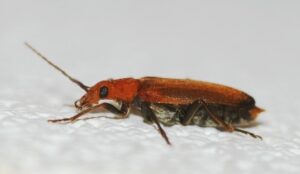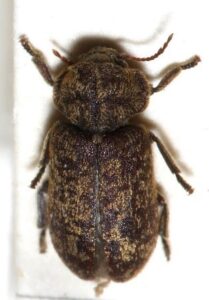Wharf Borers:
Wharf Borer or Pavement Borer
General Description

Credit: Alvesgaspar
Credit: Caroline Harding |

Credit: Alvesgaspar |
- Adults are around 1-1.2 cm in length, yellowish to reddish-orange in color. The whole body is covered with dense yellow frills and the antennae are more than half the length of the body.
- Eggs are creamy white in color, slightly curved with tapered ends.
- Larvae are creamy white, equipped with brown mandibles, and covered with brown bristles. The mouthparts and the tips of the oral palps are dark brown.
- Pupae are cream white and last 6–17 days.
Life Cycle and Common Characteristics
- Wharf borer adults may be present in different types of habitats but larvae are almost always restricted to damp, rotten wood. Buried pieces of wood may also harbor the insects.
- Females lay eggs in any damp, decaying timbers.
- The development time from egg to adult is about 12 months, and adults tend to emerge around June to late August.
- Eggs are deposited on wood surfaces where they are subjected to temperature extremes.
- Egg longevity is 5–11 days.
- First instar larvae burrow about 1 cm beneath the surface of the wood after hatching, where soft-rot type degradation is evident.
- Larva mainly feed on damp and decaying wood found along waterways and coastlines.
- The larval stage is reported to last from up to 2 -24 months, during which time larvae digest cellulose and hemicellulose.
- They emerge from the resting pupal stage between May and September.
- Adults are short-lived (2–10 days), non-feeding, free-living, able to fly and can locate wood via olfactory cues.
- Females are not substrate specific when choosing an oviposition site.
Damage and Economic Implications
- It is a household pest that infests very wet wood, such as in wood foundations adjacent to sewage or water connections, or rotten tree trunks
- Wharf borers are known to infest both hardwood and softwood.
- Adults can emerge from under the floor of buildings in quite large numbers, causing the occupants to think they may be being invaded by cockroaches.
- Adults are quite harmless.




